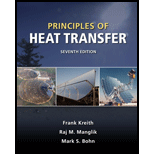
Concept explainers
Consider a flat plate or a plane wall with a thickness L and a long cylinder of radius
The characteristic length for a long cylinder and flat plate
Explanation of Solution
Characteristic length for long cylinder:
For long cylinders heat transfer through ends can be neglected, as the surface area at ends is negligible in comparisons with the total surface area of cylinder.
“r” is radius of the cylinder.
“L” is length of the cylinder.
Characteristic length for plane wall or flat plate:
The plate should be very thin so that internal resistance of the plate is negligible and lumped parameter analysis can be used.
For thin plates heat transfer through ends can be neglected as, heat transfer area at ends is negligible in compression with total surface area of the plate.
L = thickness of the plate.
“b” and “h” are width and height of the plate.
Want to see more full solutions like this?
Chapter 3 Solutions
Principles of Heat Transfer
- What are the reactive forces at A and B on the two gates (P1 and P2) in the figure? *The gates are cylindrical, 5 meters long and 1/4 of a circle with a radius of 7arrow_forwardMy answer here is R_av= 150 kN, R_b= 210 kN amd R_ah= 0 kN please verfy if my answers are correctarrow_forwardA wire of length L₁ = 30 cm has one end fixed and the other end welded to another wire, whose linear density of mass is 4 times smaller. The second wire passes through a pulley and a mass of 10 kg is suspended by its other end. The distance L₂ between the weld point and the pulley is 80 cm. A stationary wave is produced in the composite wire, whose ends at the left wall and the pulley remain fixed. If the frequency is as low as possible and there is one node (node) at the solder point, what is the number of nodes (nodes) of this stationary wave, including the nodes (nodes) at the left wall and the pulley? a. 3b. 4c. 5d. 6e. 7f. 8g. 9h. 10a. 11j. 12k. 13l. 14m. 15arrow_forward
- Determine the effiency of the fin ?arrow_forwardA wire of length L1=30cm has a fixed end and the other end is welded to another wire, whose linear mass density is 4 times smaller. The second wire passes over a pulley and a mass of 10kg is suspended from its other end.The distance L2 between the welding point and the pulley is 80 cm. A standing wave is produced in the composite wire, whose ends on the left wall and on the pulley remain fixed.If the frequency is as low as possible and there is a node at the weld spot, what is the number of nodes in this standing wave, including nodes on the left wall and on the pulley?a)3b)4c)5d)6e)7f)8g)9h)10i)11j)12k)13l)14m)15arrow_forwardA coil consists of 2000 turns of copper wire having a circular - section of diameter 2.5 mm. The mean length per turn is 80 cm and the electrical resistivity of copper is 0.02 μΩ–m. Determine the resistance of the coil.arrow_forward
- Calculate the resistive force acting on the disk, with the error level not less than h^4, according to the pressure distribution on a circular disk of 0.5 m diameter held against the air flow, given in the table below.arrow_forwardWhat are the reactive forces at A and B on the gates in the figure? The gates are cylindrical, 5 meters long and 1/4 of a circle with a radius of 7arrow_forwardThe surface tesnion of waterr in contact with air at 20deg C is given at 0.0716 N/m. The pressure inside a droplet of water is to be 0.0147 N/cm^2 greater than the outside pressure, calculate the diameter in mm of the droplet of water. a.2.43 b.4.62 c.3.60 d.1.94arrow_forward
 Principles of Heat Transfer (Activate Learning wi...Mechanical EngineeringISBN:9781305387102Author:Kreith, Frank; Manglik, Raj M.Publisher:Cengage Learning
Principles of Heat Transfer (Activate Learning wi...Mechanical EngineeringISBN:9781305387102Author:Kreith, Frank; Manglik, Raj M.Publisher:Cengage Learning
